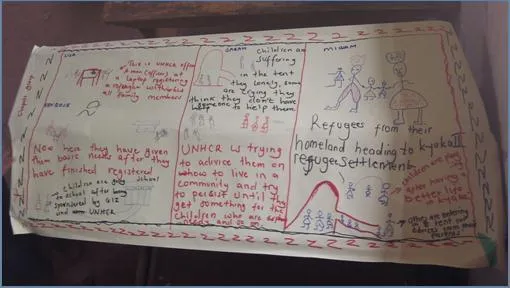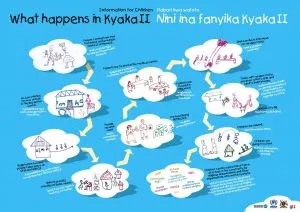Child friendly information on the refugee protection process...

The last blog provided, among other things, a snapshot of feedback on the protection process coming out of the participatory workshops with refugee children in Kyaka II. One issue identified was how children feel at the point of arrival in the settlement (or as new arrivals staying in the Reception Centre) and their specific needs in terms of information.NEW_LINENEW_LINEWhen asked, amongst other problems that refugee children in the Reception Centre felt they faced on arrival in Kyaka II, children mentioned a lack of information uncertainty and confusion about what happens next.NEW_LINENEW_LINEEven children who had been living in the settlement for longer, when consulted on their views on the different stages of the protection process, fed back that they had learned, remembered or better understood the refugee protection process as a result of the workshops i.e. they were unclear and confused about this before:NEW_LINENEW_LINE‘She was able to know about the pictures and [protection] process. She had forgotten everything but now has remembered.’NEW_LINENEW_LINEOlder refugee children who had been living and attending school for some time in the settlement were, however (as would be expected), much clearer about the refugee protection process and its operation in Kyaka II. Workshops with these children produced clearer explanations of the different stages in the protection process, as well as annotated illustrations of each stage from a child’s point of view:NEW_LINENEW_LINE‘They are leaving from their place. They leave their property to another. The GIZ people giving the people what they need, saying: 'We are going to welcome the refugee'. In the GIZ office they get ball, saucepan, jerry can. Now these ones, they are very happy to get their needs met. To use these materials they feel very happy to receive. Now here they turn home, coming from GIZ office.’NEW_LINENEW_LINE

NEW_LINENEW_LINEWhilst new arrivals and those living in the Reception Centre receive support and information from humanitarian organisations working in Kyaka II, there is no systematic provision of information given specifically to and for refugee children on the protection process. Whilst individual children were able to recount useful information that they had been given by practitioners at the point of arrival in the settlement - for example:NEW_LINENEW_LINE‘Can’t remember names but they told them if having any problems to go to the office. Showed them where the water is. Gave them information - told them training for soldiers nearby, so even if they hear the sound of bullets, they shouldn't fear. They shouldn't fear.. when moving…no animals that can eat them…’NEW_LINENEW_LINE- they were not necessarily aware of the overall picture of what happens in terms of their protection in Kyaka II. In workshops and interviews, both children and adults generally communicated the message that refugee children are not usually specifically or systematically communicated to but rely on what they can gather listening in to adult discussions, gain from their peers or from information ‘trickled down’ to them from adults that they know.NEW_LINENEW_LINEAs part of conducting the research in Kyaka II, the Researcher provided interim feedback reports to practitioners working in the settlement. Based on the feedback from the children’s workshops above, the GIZ Protection and Community Services team proposed initiating child-friendly sensitisation sessions for children at the arrival point, separate but complementary to those given to adults. It was also decided that a child-friendly signpost and poster could be designed, using the children’s explanations and diagrams of the protection process to inform other children who have newly arrived or who are less informed across the settlement.NEW_LINENEW_LINEIn partnership with OPM, UNHCR and GIZ, a child friendly poster on the protection process was produced. This will be displayed in key locations across Kyaka II – for example, at the health centre, in schools, in community buildings, on notice boards in the different settlement zones – as well as in signpost form in the Reception Centre for all new arrivals to see. Photographs of the poster and signpost in situ will be provided by GIZ and its Community Protection Workers consulted on their impact for children.NEW_LINENEW_LINE

NEW_LINENEW_LINEAnna Skeels, PhD Student, CMPR – Swansea University
Stay updated
Sign up for our newsletter to receive regular updates on resources, news, and insights like this. Don’t miss out on important information that can help you stay informed and engaged.
Related articles
.png)


Explore Elrha
Learn more about our mission, the organisations we support, and the resources we provide to drive research and innovation in humanitarian response.